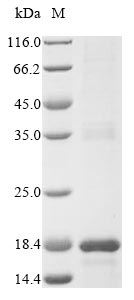In the production of recombinant S. epidermidis epiA protein, the gene for epiA (E.coli) was cloned into a vector and expressed as epiA protein in E.coli. The plasmids with the copy of epiA, or the expression vector, were often used to enhance gene expression. Every step of production was undergone with a strict QC system. N-terminal 6xHis-KSI tag was used in the process. The purity is 85% determined by SDS-PAGE.
The Staphylococcus epidermidis genes encoding the His-tag-labelled epidermin precursor peptide EpiA. The 52-amino acid prepeptide EpiA consists of an N-terminal leader peptide with amino acids - 30 to - 1 and a C-terminal pro-epidermin with amino acids + 1 to + 22. EpiA is post-translationally converted to the mature antibiotic by dehydration of serine and threonine residues, sulfide bridge formation, oxidative decarboxylation at the C-terminus and removal of the leader peptide. enzymes involved in epidermin biosynthesis. Studies identified that EpiA was expressed in Escherichia coli using a malE-epiA fusion. The identity of purified EpiA was confirmed by ion spray mass spectrometry and amino acid sequencing. For EpiA detection, anti-EpiA antisera were raised. Upon prolonged incubation, factor Xa not only cleaved EpiA from the fusion protein, but also less efficiently cleaved EpiA internally between R-1 and I + 1.






